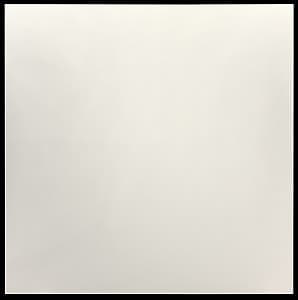

Robert Ryman
Learn moreArena 1977
Purchased 1978
More detail | PermalinkAs well as being concerned with ‘how to paint’, Robert Ryman also defines his ambition as ‘to paint the paint’.[1] From his initial attempts to understand the act of painting in the mid 1950s, his work has continued to be defined by his attention to surface and space. ‘The basic problem is what to do with the paint. What is done with the paint is the essence of all painting.’[2] Ryman restricts himself to the fundamentals of painting, a square format and one colour, and for this reason is free to concentrate on manipulating scale and texture. He makes use of a range of media, and all sorts of supports. Looking at a mural of about 300 photographs of Ryman’s paintings since the 1950s in the artist’s studio, Robert Storr detected no obvious succession of technique or variance in his work. Storr noted that Ryman’s preoccupation with the act of making a painting has produced ‘an ever-increasing number of similarly concise statements about what paint can do’. The work ‘hasn’t progressed so much as elaborated itself under the artist’s close watch’.[3]
It is the physical presence of the paint on a surface, and the relation between the canvas (or support) and the wall, that interests Ryman. Influenced by Mark Rothko’s approach to the canvas as object―rather than a conventionally flat screen onto which the artist places lights or shapes or marks―Ryman paints around the edge of the stretcher and presents his work as unframed. By severely limiting the palette and format of his work, the artist stresses the absolute importance of the application of pigment to surface. Ryman’s is a highly refined examination of the optical and material properties of the discipline of painting. Subtle variations in surface, brushwork and materials heighten the viewer’s sensitivity. His ‘whites’ may be crusty or suave, opaque or sheer, as warm as fresh cream or as cool as ceramic tiles. Arena 1977 is characterised by an extremely depersonalised and evenly-painted surface. The artist has used an air-drying polyurethane coating material, varathane, which imparts sheen to the wax-like surface. In the late 1970s he produced relatively few paintings, but these were undergoing immense development, and he later gradually returned to a more spontaneous style.
In 1976 Ryman introduced visible custom-made fasteners to connect his paintings directly to the wall. Appearing for the first time on his pastel drawings on plexiglass, these fasteners are in some respects a further development of the adhesive strips of 1968, but without their practical purpose. The devices are designed by the artist and have both functional and compositional roles, taking into account scale and shape, colour and light reflectiveness; some are steel, some cadmium and others black oxide.[4] With Arena the fasteners serve to angle the work so it appears larger and seems to intrude into the viewer’s space. Ryman steadily and increasingly varied the possibilities, and until 1980 no paintings were made without fasteners. Pictorial complexity, as Alfred Pacquement points out, is achieved with an ‘extremely restricted vocabulary’.[5]
Lucina Ward
[1] Ryman, statements 1969 and 1979, in Art in process: the visual development of a collage, Finch College Museum of Art, New York, 1967 and interview with Barbaralee Diamonstein in Inside New York’s art world, Rizzoli, New York, 1979, p 332, quoted in Robert Storr, Robert Ryman, Tate Gallery, London, 1993, p 18.
[2] Robert Ryman, Stedelijk Museum, Amsterdam, 1974, quoted in Robert Ryman, Dia Art Foundation, New York, 1988, p 24.
[3] Storr, pp 9–10.
[4] Embassy I 1976 is oil and acrylic on acrylic sheet. Ryman drilled into the plexiglass, using black oxide steel fasteners to attach it to the wall; Crex Collection, Hallen für neue Kunst, Schaffhausen. In another related work, Advance 1976―oil on blue Acrylivin with vinyl, Elvacite and sanded plexiglass fasteners with cadmium bolts―strips of plastic sheet strap the work to the wall, while providing a subtle framing device; Collection Franz Meyer.
[5] Alfred Pacquement, ‘Robert Ryman’ in Dr Judith Rodenbeck (ed), Grove Art Online, http://www.oxfordartonline.com/groveart, accessed 14 February 2018.

